Interpreter in Apache Zeppelin
Overview
In this section, we will explain the role of interpreters, interpreter groups and interpreter settings in Zeppelin. The concept of Zeppelin interpreters allows any language or data-processing backend to be plugged into Zeppelin. Currently, Zeppelin supports many interpreters such as Scala (with Apache Spark), Python (with Apache Spark), Spark SQL, Hive, JDBC, Markdown, Shell and so on.
What are Zeppelin Interpreters ?
A Zeppelin interpreter is a plug-in which enables Zeppelin users to use a specific language/data-processing-backend. For example, to use Scala code in Zeppelin, you would use the %spark interpreter.
When you click the +Create button on the interpreter page, the interpreter drop-down list box will show all the available interpreters on your server.
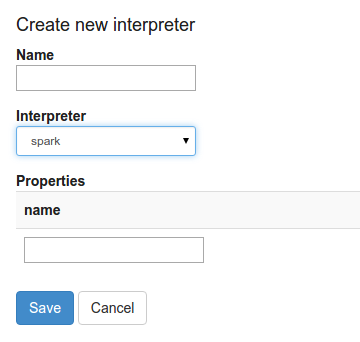
You can create multiple interpreters for the same engine with different interpreter setting. e.g. You can create spark2 for Spark 2.x and create spark1 for Spark 1.x.
For each paragraph you write in Zeppelin, you need to specify its interpreter first via %interpreter_group.interpreter_name. e.g. %spark.pyspark, %spark.r.
If you specify interpreter, you can also pass local properties to it (if it needs them). This is done by providing a set of key/value pairs, separated by comma, inside the round brackets right after the interpreter name. If key or value contain characters like =, or ,, then you can either escape them with \ character, or wrap the whole value inside the double quotes For example:
%cassandra(outputFormat=cql, dateFormat="E, d MMM yy", timeFormat=E\, d MMM yy)
What are the Interpreter Settings?
The interpreter settings are the configuration of a given interpreter on the Zeppelin server. For example, certain properties need to be set for the Apache Hive JDBC interpreter to connect to the Hive server.
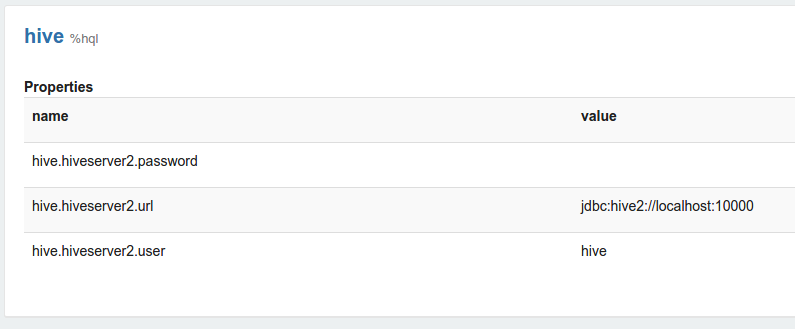
Properties are exported as environment variables on the system if the property name consists of upper-case characters, numbers or underscores ([A-Z_0-9]). Otherwise, the property is set as a common interpreter property.
e.g. You can define SPARK_HOME and HADOOP_CONF_DIR in spark's interpreter setting, they are be passed to Spark interpreter process as environment variable which is used by Spark.
You may use parameters from the context of the interpreter by adding #{contextParameterName} in the interpreter property value. The parameter can be of the following types: string, number, boolean.
Context Parameters
| Name | Type |
|---|---|
| user | string |
| noteId | string |
| replName | string |
| className | string |
If the context parameter is null, then it is replaced by an empty string. The following screenshot is one example where we make the user name as the property value of default.user.

What are Interpreter Groups ?
Every interpreter belongs to an Interpreter Group. Interpreter Groups are units of interpreters that run in one single JVM process and can be started/stopped together. By default, every interpreter belongs to a separate group, but the group might contain more interpreters. For example, the Spark interpreter group includes Scala Spark, PySpark, IPySpark, SparkR and Spark SQL.
Technically, Zeppelin interpreters from the same group run within the same JVM. For more information about this, please consult the documentation on writing interpreters.
Each interpreter belongs to a single group and is registered together. All relevant properties are listed in the interpreter setting as in the below example.
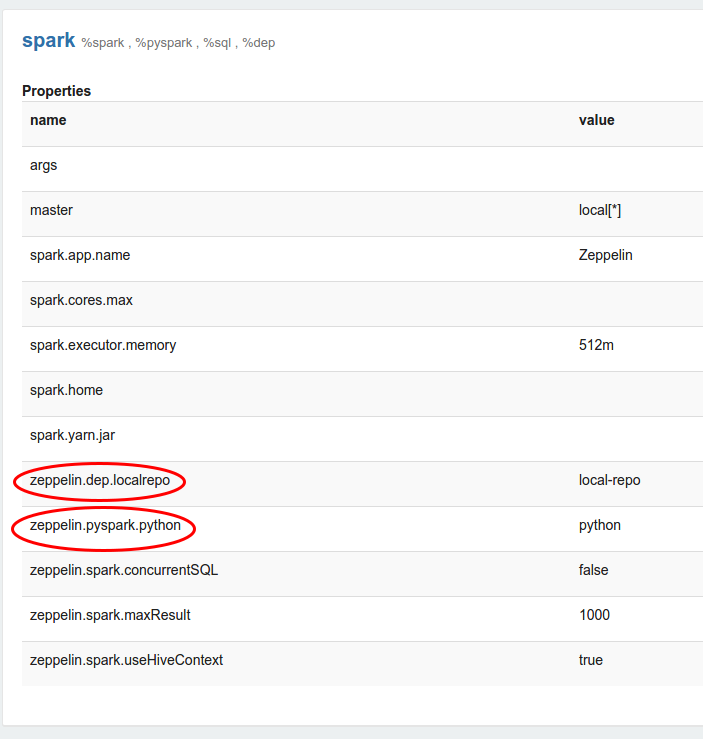
Interpreter Binding Mode
In the Interpreter Settings, one can choose one of the shared, scoped, or isolated interpreter binding modes.
In shared mode, every note/user using this interpreter will share a single interpreter instance.
scoped and isolated mode can be used under 2 dimensions: per user or per note.
e.g. In scoped per note mode, each note will create a new interpreter instance in the same interpreter process. In isolated per note mode, each note will create a new interpreter process.
For more information, please consult Interpreter Binding Mode.
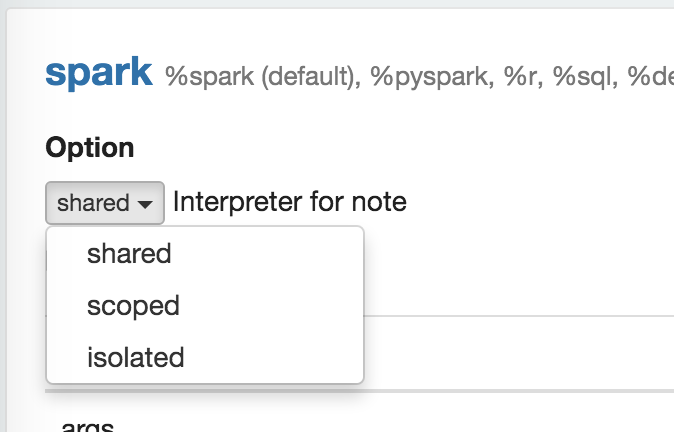
Interpreter Lifecycle Management
Before 0.8.0, Zeppelin doesn't have lifecycle management for interpreters. Users had to shut down interpreters explicitly via the UI. Starting from 0.8.0, Zeppelin provides a new interface
LifecycleManager to control the lifecycle of interpreters. For now, there are two implementations: NullLifecycleManager and TimeoutLifecycleManager.
NullLifecycleManager will do nothing, i.e., the user needs to control the lifecycle of interpreter by themselves as before. TimeoutLifecycleManager will shut down interpreters after an interpreter remains idle for a while. By default, the idle threshold is 1 hour.
Users can change this threshold via the zeppelin.interpreter.lifecyclemanager.timeout.threshold setting. NullLifecycleManager is the default lifecycle manager, and users can change it via zeppelin.interpreter.lifecyclemanager.class.
Inline Generic Configuration
Zeppelin's interpreter setting is shared by all users and notes, if you want to have different settings, you have to create a new interpreter, e.g. you can create spark_jar1 for running Spark with dependency jar1 and spark_jar2 for running Spark with dependency jar2.
This approach works, but is not convenient. Inline generic configuration can provide more fine-grained control on interpreter settings and more flexibility.
ConfInterpreter is a generic interpreter that can be used by any interpreter. You can use it just like defining a java property file.
It can be used to make custom settings for any interpreter. However, ConfInterpreter needs to run before that interpreter process is launched. When that interpreter process is launched is determined by the interpreter binding mode setting.
So users need to understand the interpreter binding mode setting of Zeppelin and be aware of when the interpreter process is launched. E.g., if we set the Spark interpreter setting as isolated per note, then under this setting, each note will launch one interpreter process.
In this scenario, users need to put ConfInterpreter as the first paragraph as in the below example. Otherwise, the customized setting cannot be applied (actually it would report ERROR).

Precode
Snippet of code (language of interpreter) that executes after initialization of the interpreter depends on Binding mode. To configure, add a parameter with the class of the interpreter (zeppelin.<ClassName>.precode) except JDBCInterpreter (JDBC precode).

Credential Injection
Credentials from the credential manager can be injected into Notebooks. Credential injection works by replacing the following patterns in Notebooks with matching credentials for the Credential Manager: {CREDENTIAL_ENTITY.user} and {CREDENTIAL_ENTITY.password}. However, credential injection must be enabled per Interpreter, by adding a boolean injectCredentials setting in the Interpreters configuration. Injected passwords are removed from Notebook output to prevent accidentally leaking passwords.
Credential Injection Setting

Credential Entry Example

Credential Injection Example
val password = "{SOME_CREDENTIAL_ENTITY.password}"
val username = "{SOME_CREDENTIAL_ENTITY.user}"
Interpreter Process Recovery (Experimental)
Before 0.8.0, shutting down Zeppelin also meant to shutdown all the running interpreter processes. Usually, an administrator will shutdown the Zeppelin server for maintenance or upgrades, but would not want to shut down the running interpreter processes.
In such cases, interpreter process recovery is necessary. Starting from 0.8.0, users can enable interpreter process recovery via the setting zeppelin.recovery.storage.class as
org.apache.zeppelin.interpreter.recovery.FileSystemRecoveryStorage or other implementations if available in the future. By default it is org.apache.zeppelin.interpreter.recovery.NullRecoveryStorage,
which means recovery is not enabled. zeppelin.recovery.dir is used for specify where to store the recovery metadata.
Enabling recovery means shutting down Zeppelin would not terminate interpreter processes, and when Zeppelin is restarted, it would try to reconnect to the existing running interpreter processes. If you want to kill all the interpreter processes after terminating Zeppelin even when recovery is enabled, you can run bin/stop-interpreter.sh.
In 0.8.x, Zeppelin server would reconnect to the running interpreter process only when you run paragraph again, but it won't recover the running paragraph. E.g. if you restart zeppelin server when some paragraph is still running, then when you restart Zeppelin, although the interpreter process is still running, you won't see the paragraph is running in frontend. In 0.9.x, we fix it by recovering the running paragraphs. Here's one screenshot of how one running paragraph of flink interpreter works.
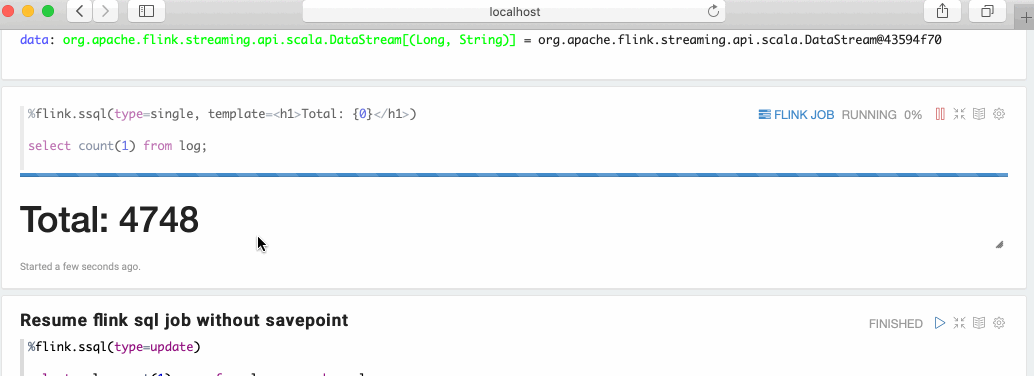
Choose Interpreters
By default, Zeppelin will register and display all the interpreters under folder $ZEPPELIN_HOME/interpreters.
But you can configure property zeppelin.interpreter.include to specify what interpreters you want to include or zeppelin.interpreter.exclude to specify what interpreters you want to exclude.
Only one of them can be specified, you can not specify them together.
